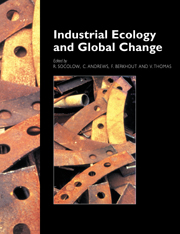Book contents
- Frontmatter
- Contents
- Foreword
- Preface
- Acknowledgments
- Contributors
- OVERVIEW
- PART 1 VULNERABILITY AND ADAPTATION
- PART 2 THE GRAND CYCLES: DISRUPTION AND REPAIR
- 8 Introduction
- 9 Human Impacts on the Carbon and Nitrogen Cycles
- 10 Charting Development Paths: A Multicountry Comparison of Carbon Dioxide Emissions
- 11 Reducing Urban Sources of Methane: An Experiment in Industrial Ecology
- 12 Reducing Carbon Dioxide Emissions in Russia
- 13 Energy Efficiency in China: Past Experience and Future Prospects
- 14 Roles for Biomass Energy in Sustainable Development
- PART 3 TOXICS AND THE ENVIRONMENT
- PART 4 INDUSTRIAL ECOLOGY IN FIRMS
- PART 5 INDUSTRIAL ECOLOGY IN POLICY-MAKING
- END PIECE
- Organizing Committee Members
- Working Groups
- Index
13 - Energy Efficiency in China: Past Experience and Future Prospects
Published online by Cambridge University Press: 04 August 2010
- Frontmatter
- Contents
- Foreword
- Preface
- Acknowledgments
- Contributors
- OVERVIEW
- PART 1 VULNERABILITY AND ADAPTATION
- PART 2 THE GRAND CYCLES: DISRUPTION AND REPAIR
- 8 Introduction
- 9 Human Impacts on the Carbon and Nitrogen Cycles
- 10 Charting Development Paths: A Multicountry Comparison of Carbon Dioxide Emissions
- 11 Reducing Urban Sources of Methane: An Experiment in Industrial Ecology
- 12 Reducing Carbon Dioxide Emissions in Russia
- 13 Energy Efficiency in China: Past Experience and Future Prospects
- 14 Roles for Biomass Energy in Sustainable Development
- PART 3 TOXICS AND THE ENVIRONMENT
- PART 4 INDUSTRIAL ECOLOGY IN FIRMS
- PART 5 INDUSTRIAL ECOLOGY IN POLICY-MAKING
- END PIECE
- Organizing Committee Members
- Working Groups
- Index
Summary
Abstract
The Chinese economy is currently undergoing rapid growth. Continued wasteful use of energy (chiefly coal) is neither economically nor environmentally feasible. Thus there is an urgent need for increased energy efficiency in China. This chapter reviews recent efficiency trends and proposes new initiatives including further energy price reform and better information for consumers.
Introduction
During the 1980s the Chinese national economy grew rapidly, while at the same time there was a serious attempt to increase energy efficiency and improve the environment. Averaged over the decade, the annual growth rate of gross national product (GNP) was 8.9%, while annual growth rate of energy consumption was 5.1%. Capital was invested in environmental protection in the years 1986 to 1990 at an average rate of 0.7% of GNP.
Between 1949 and 1990 commercial energy production (consisting of coal, oil, natural gas, and hydropower) grew more than 40 times. In the same period the dominance of coal decreased somewhat, to 73% of commercial consumption. Total commercial energy consumption in China was 29.0 EJ (990 million tons of coal equivalent, or Mtce, in the common unit of energy policy discourse in China1), with the industrial sector dominating the transportation and buildings sectors to a much greater extent than in more highly industrialized countries. China is a self-contained energy economy: in fact, in 1990 energy production exceeded energy consumption by 5%.
Pollution from coal burning is still increasing, because pollution control measures are not keeping up with expanded use. The control of smoke and dust at the stack or chimney is incomplete, as is the control of emissions of sulfur dioxide—leading some regions to suffer from acid rain.
- Type
- Chapter
- Information
- Industrial Ecology and Global Change , pp. 193 - 198Publisher: Cambridge University PressPrint publication year: 1994



